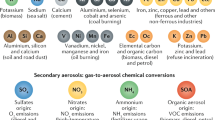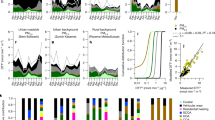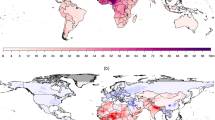Abstract
Assessment of the global burden of disease is based on epidemiological cohort studies that connect premature mortality to a wide range of causes1,2,3,4,5, including the long-term health impacts of ozone and fine particulate matter with a diameter smaller than 2.5 micrometres (PM2.5)3,4,5,6,7,8,9. It has proved difficult to quantify premature mortality related to air pollution, notably in regions where air quality is not monitored, and also because the toxicity of particles from various sources may vary10. Here we use a global atmospheric chemistry model to investigate the link between premature mortality and seven emission source categories in urban and rural environments. In accord with the global burden of disease for 2010 (ref. 5), we calculate that outdoor air pollution, mostly by PM2.5, leads to 3.3 (95 per cent confidence interval 1.61–4.81) million premature deaths per year worldwide, predominantly in Asia. We primarily assume that all particles are equally toxic5, but also include a sensitivity study that accounts for differential toxicity. We find that emissions from residential energy use such as heating and cooking, prevalent in India and China, have the largest impact on premature mortality globally, being even more dominant if carbonaceous particles are assumed to be most toxic. Whereas in much of the USA and in a few other countries emissions from traffic and power generation are important, in eastern USA, Europe, Russia and East Asia agricultural emissions make the largest relative contribution to PM2.5, with the estimate of overall health impact depending on assumptions regarding particle toxicity. Model projections based on a business-as-usual emission scenario indicate that the contribution of outdoor air pollution to premature mortality could double by 2050.
This is a preview of subscription content, access via your institution
Access options
Subscribe to this journal
Receive 51 print issues and online access
$199.00 per year
only $3.90 per issue
Buy this article
- Purchase on Springer Link
- Instant access to full article PDF
Prices may be subject to local taxes which are calculated during checkout


Similar content being viewed by others
References
Murray, C. & Lopez, A. D. The Global Burden of Disease: A Comprehensive Assessment of Mortality and Disability from Diseases, Injuries, and Risk Factors in 1990 and Projected in 2020 (Harvard Univ. Press, 1996)
Ezzati, M. et al. Selected major risk factors and global and regional burden of disease. Lancet 360, 1347–1360 (2002)
Ostro, B. Outdoor Air Pollution: Assessing the Environmental Burden of Disease at National and Local Levels (World Health Organization Environmental Burden of Disease Series No. 5, WHO, Geneva, 2004)
Cohen, A. J. et al. The global burden of disease due to outdoor air pollution. J. Toxicol. Environ. Health A 68, 1301–1307 (2005)
Lim, S. S. et al. A comparative risk assessment of burden of disease and injury attributable to 67 risk factors and risk factor clusters in 21 regions, 1990–2010: a systematic analysis for the Global Burden of Disease Study 2010. Lancet 380, 2224–2260 (2012); correction 381, 628 (2013)
Pope, C. A., III & Dockery, D. W. Health effects of fine particulate air pollution: lines that connect. J. Air Waste Manag. Assoc. 56, 709–742 (2006)
Beelen, R. et al. Effects of long-term exposure to air pollution on natural-cause mortality: an analysis of 22 European cohorts within the multicentre ESCAPE project. Lancet 383, 785–795 (2014)
Burnett, R. T. et al. An integrated risk function for estimating the Global Burden of Disease attributable to ambient fine particulate matter exposure. Environ. Health Perspect. 122, 397–403 (2014)
Jerrett, M. et al. Long-term ozone exposure and mortality. N. Engl. J. Med. 360, 1085–1095 (2009)
Tuomisto, J. T., Wilson, A., Evans, J. S. & Tainio, M. Uncertainty in mortality response to airborne fine particulate matter: combining European air pollution experts. Reliab. Eng. Syst. Saf. 93, 732–744 (2008)
Pope, C. A., III et al. Lung cancer, cardiopulmonary mortality, and long-term exposure to fine particulate air pollution. J. Am. Med. Assoc. 287, 1132–1141 (2002)
Prüss-Üstün, A., Bonjour, S. & Corvalan, C. The impact of the environment on health by country: a meta-synthesis. Environ. Health 7, http://dx.doi.org/10.1186/1476-069X-7-7 (2008)
Russell, A. G. & Brunekreef, B. A focus on particulate matter and health. Environ. Sci. Technol. 43, 4620–4625 (2009)
Gurjar, B. R. et al. Human health risks in megacities due to air pollution. Atmos. Environ. 44, 4606–4613 (2010)
West, J. J., Fiore, A. M., Horowitz, L. W. & Mauzerall, D. L. Global health benefits of mitigating ozone pollution with methane emission controls. Proc. Natl Acad. Sci. USA 103, 3988–3993 (2006)
Duncan, B. N. et al. The influence of European pollution on ozone in the Near East and northern Africa. Atmos. Chem. Phys. 8, 2267–2283 (2008)
Liu, J., Mauzerall, D. L. & Horowitz, L. W. Evaluating inter-continental transport of fine aerosols: (2) Global health impact. Atmos. Environ. 43, 4339–4347 (2009)
Anenberg, S. C., Horowitz, L. W., Tong, D. Q. & West, J. J. An estimate of the global burden of anthropogenic ozone and fine particulate matter on premature human mortality using atmospheric modeling. Environ. Health Perspect. 118, 1189–1195 (2010)
Fann, N. et al. Estimating the national public health burden associated with exposure to ambient PM2.5 and ozone. Risk Anal. 32, 81–95 (2012)
Silva, R. A. et al. Global premature mortality due to anthropogenic outdoor air pollution and the contribution of past climate change. Environ. Res. Lett. 8, http://dx.doi.org/10.1088/1748-9326/8/3/034005 (2013)
Lelieveld, J., Barlas, C., Giannadaki, D. & Pozzer, A. Model calculated global, regional and megacity premature mortality due to air pollution by ozone and fine particulate matter. Atmos. Chem. Phys. 13, 7023–7037 (2013)
Giannadaki, D., Pozzer, A. & Lelieveld, J. Modeled global effects of airborne desert dust on air quality and premature mortality. Atmos. Chem. Phys. 14, 957–968 (2014)
van Donkelaar, A. et al. Global estimates of ambient fine particulate matter concentrations from satellite-based aerosol optical depth: development and application. Environ. Health Perspect. 118, 847–855 (2010)
Brauer, M. et al. Exposure assessment for estimation of the Global Burden of Disease attributable to outdoor air pollution. Environ. Sci. Technol. 46, 652–660 (2012)
Thurston, G. D. et al. in National Particle Component Toxicity (NPACT) Initiative: Integrated Epidemiologic and Toxicologic Studies of the Health Effects of Particulate Matter Components (eds Lippmann, M. et al.) 127–166 (Health Effects Institute Research Report 177, Boston, 2013)
Lippmann M., et al. (eds) National Particle Component Toxicity (NPACT) Initiative: Integrated Epidemiologic and Toxicologic Studies of the Health Effects of Particulate Matter Components (Health Effects Institute Research Report 177, Boston, 2013)
Vedal, S. et al. National Particle Component Toxicity (NPACT) Initiative: Report on Cardiovascular Effects (Health Effects Institute Research Report 178, Boston, 2013)
Yang, G. et al. Rapid health transition in China, 1990–2010: findings from the Global Burden of Disease Study 2010. Lancet 381, 1987–2015 (2013)
Megaritis, A. G., Fountoukis, C., Charalampidis, P. E., Pilinis, C. & Pandis, S. N. Response of fine particulate matter concentrations to changes of emissions and temperature in Europe. Atmos. Chem. Phys. 13, 3423–3443 (2013)
Ginoux, P., Prospero, J. M., Gill, T. E., Hsu, N. C. & Zhao, M. Global-scale attribution of anthropogenic and natural dust sources and their emission rates based on MODIS Deep Blue aerosol products. Rev. Geophys. 50, RG3005 (2012)
Tager, I. et al. Traffic-related Air Pollution: A Critical Review of the Literature on Emissions, Exposure, and Health Effects (Health Effects Institute Special Report 17, Boston, 2010)
Pozzer, A. et al. Effects of business-as-usual anthropogenic emissions on air quality. Atmos. Chem. Phys. 12, 6915–6937 (2012)
Roeckner, E. et al. Sensitivity of simulated climate to horizontal and vertical resolution in the ECHAM5 atmosphere model. J. Clim. 19, 3771–3791 (2006)
Jöckel, P. et al. Technical Note: The Modular Earth Submodel System (MESSy) – a new approach towards earth system modeling. Atmos. Chem. Phys. 5, 433–444 (2005)
Jöckel, P. et al. The atmospheric chemistry general circulation model ECHAM5/MESSy: Consistent simulation of ozone from the surface to the mesosphere. Atmos. Chem. Phys. 6, 5067–5104 (2006)
Pozzer, A., Jöckel, P., Kern, B. & Haak, H. The atmosphere-ocean general circulation model EMAC-MPIOM. Geosci. Model Dev. 4, 771–784 (2011)
Sander, R., Kerkweg, A., Jöckel, P. & Lelieveld, J. Technical note: The new comprehensive atmospheric chemistry module MECCA. Atmos. Chem. Phys. 5, 445–450 (2005)
Kerkweg, A. et al. Technical Note: An implementation of the dry removal processes DRY DEPosition and SEDImentation in the Modular Earth Submodel System (MESSy). Atmos. Chem. Phys. 6, 4617–4632 (2006)
Tost, H. et al. Technical note: A new comprehensive SCAVenging submodel for global atmospheric chemistry modeling. Atmos. Chem. Phys. 6, 565–574 (2006)
Tost, H. et al. Global cloud and precipitation chemistry and wet deposition: tropospheric model simulations with ECHAM5/MESSy1. Atmos. Chem. Phys. 7, 2733–2757 (2007)
Pozzer, A. et al. Technical Note: The MESSy-submodel AIRSEA calculating the air-sea exchange of chemical species. Atmos. Chem. Phys. 6, 5435–5444 (2006)
Pozzer, A. et al. Simulating organic species with the global atmospheric chemistry general circulation model ECHAM5/MESSy1: a comparison of model results with observations. Atmos. Chem. Phys. 7, 2527–2550 (2007)
Pozzer, A., Jöckel, P. & van Aardenne, J. The influence of the vertical distribution of emissions on tropospheric chemistry. Atmos. Chem. Phys. 9, 9417–9432 (2009)
Pozzer, A. et al. Distributions and regional budgets of aerosols and their precursors simulated with the EMAC chemistry-climate model. Atmos. Chem. Phys. 12, 961–987 (2012)
Astitha, M. et al. Parameterization of dust emissions in the global atmospheric chemistry-climate model EMAC: impact of nudging and soil properties. Atmos. Chem. Phys. 12, 11057–11083 (2012)
Pringle, K. J. et al. Description and evaluation of GMXe: A new aerosol submodel for global simulations (v1). Geosci. Model Dev. 3, 391–412 (2010)
Pringle, K. J. et al. Global distribution of the effective aerosol hygroscopicity parameter for CCN activation. Atmos. Chem. Phys. 10, 5241–5255 (2010)
de Meij, A. et al. EMAC model evaluation and analysis of atmospheric aerosol properties and distribution. Atmos. Res. 114-115, 38–69 (2012)
Christoudias, T. & Lelieveld, J. Modelling the global atmospheric transport and deposition of radionuclides from the Fukushima Dai-ichi nuclear accident. Atmos. Chem. Phys. 13, 1425–1438 (2013)
Doering, U., Janssens-Maenhout, G., van Aardenne, J. & Pagliari, V. Climate Change and Impact Research in the Mediterranean Environment: Scenarios of Future Climate Change. JRC Tech. Note 62957 (Joint Research Centre, Ispra, 2010)
Van Aardenne, J. et al. Climate and Air Quality Impacts of Combined Climate Change and Air Pollution Policy Scenarios. JRC Sci. Tech. Rep. 61281 http://dx.doi.org/10.2788/33719 (Joint Research Centre, Ispra, 2010)
Shindell, D. et al. Simultaneously mitigating near-term climate change and improving human health and food security. Science 335, 183–189 (2012)
Stocker, T. F. et al. (eds) Climate Change 2013: The Physical Science Basis (Cambridge Univ. Press, 2013)
Russ, P., Wiesenthal, T., van Regenmorter, D. & Ciscar, J. C. Global Climate Policy Scenarios for 2030 and Beyond. Analysis of Greenhouse Gas Emission Reduction Pathway Scenarios with the POLES and GEM-E3 models. JRC Ref. Rep. EUR 23032 EN, http://ipts.jrc.ec.europa.eu/publications/pub.cfm?id=1510 (Joint Research Centre, Ispra, 2007)
Bouwman A. F., Kram T., Klein Goldewijk K., eds. Integrated Modelling of Global Environmental change. An Overview of IMAGE 2.4 (Netherlands Environmental Assessment Agency (MNP), Bilthoven, 2006)
Taylor, K., Williamson, D. & Zwiers, F. The Sea Surface Temperature and Sea Ice Concentration Boundary Conditions for AMIP II Simulations. PCMDI Tech. Rep. 60 (Program for Climate Model Diagnosis and Intercomparison, Lawrence Livermore National Laboratory, Livermore, California, 2000)
Hurrell, J. et al. A new sea surface temperature and sea ice boundary dataset for the Community Atmosphere Model. J. Clim. 21, 5145–5153 (2008)
Jacob, D. J. & Winner, D. A. Effect of climate change on air quality. Atmos. Environ. 43, 51–63 (2009)
Pye, H. O. T. et al. Effect of changes in climate and emissions on future sulfate-nitrate-ammonium aerosol levels in the United States. J. Geophys. Res. 114 D01205, http://dx.doi.org/10.1029/2008JD010701 (2009)
Hedegaard, G. B., Christensen, J. H. & Brandt, J. The relative importance of impacts from climate change vs. emissions change on air pollution levels in the 21st century. Atmos. Chem. Phys. 13, 3569–3585 (2013)
Naik, V. et al. Preindustrial to present-day changes in tropospheric hydroxyl radical and methane lifetime from the Atmospheric Chemistry and Climate Model Intercomparison Project (ACCMIP). Atmos. Chem. Phys. 13, 5277–5298 (2013)
Fang, Y. et al. Impacts of 21st century climate change on global air pollution-related premature mortality. Clim. Change 121, 239–253 (2013)
Jones, A. M., Yin, J. & Harrison, R. M. The weekday–weekend difference and the estimation of the non-vehicle contributions to the urban increment of airborne particulate matter. Atmos. Environ. 42, 4467–4479 (2008)
Harrison, R. M., Laxen, D., Moorcroft, S. & Laxen, K. Processes affecting concentrations of fine particulate matter (PM2.5) in the UK atmosphere. Atmos. Environ. 46, 115–124 (2012)
Moussiopoulos, N. et al. An approach for determining urban concentration increments. Int. J. Environ. Pollut. 50, 376–385 (2012)
Timmermans, R. M. A. et al. Quantification of the urban air pollution increment and its dependency on the use of down-scaled and bottom-up city emission inventories. Urban Clim. 6, 44–62 (2013)
Zhang, R. et al. Chemical characterization and source apportionment of PM2.5 in Beijing: seasonal perspective. Atmos. Chem. Phys. 13, 7053-7074 (2013); Atmos. Chem. Phys. 14, 175 (2014)
Blanchard, C. L., Tanenbaum, S. & Lawson, D. R. Differences between weekday and weekend air pollutant levels in Atlanta; Baltimore; Chicago; Dallas–Fort Worth; Denver; Houston; New York; Phoenix; Washington, DC; and surrounding areas. J. Air Waste Manag. Assoc. 58, 1598–1615 (2008)
World Health Organization. World Health Organization Statistical Information System (WHOSIS), Detailed Data Files of the WHO Mortality Database http://www.who.int/healthinfo/statistics/mortality_rawdata/en/ (WHO, Geneva, 2012)
United Nations Department of Economic and Social Affairs/Population Division. World Population Prospects: the 2004 Revision. E.05.XIII.12 (United Nations, 2005)
Kinney, P. L. et al. On the use of expert judgment to characterize uncertainties in the health benefits of regulatory controls of particulate matter. Environ. Sci. Policy 13, 434–443 (2010)
Roman, H. A. et al. Expert judgment assessment of the mortality impact of changes in ambient fine particulate matter in the U.S. Environ. Sci. Technol. 42, 2268–2274 (2008)
Cao, J. et al. Association between long-term exposure to outdoor air pollution and mortality in China: A cohort study. J. Hazard. Mater. 186, 1594–1600 (2011)
Acknowledgements
We are grateful to the EDGAR team of the Joint Research Centre in Ispra, Italy, for the emission data. We acknowledge support from the Distinguished Scientist Fellowship Program at the King Saud University, Riyadh. The research leading to these results has received funding from the European Research Council under the European Union’s Seventh Framework Programme (FP7/2007-2013)/ERC grant agreement no. 226144.
Author information
Authors and Affiliations
Contributions
J.L., A.P. and M.F. planned the research, A.P. performed the model calculations, J.L., A.P., D.G. and J.S.E. analysed the results, and J.L. and J.S.E. wrote the paper. All authors contributed to the manuscript.
Corresponding author
Ethics declarations
Competing interests
The authors declare no competing financial interests.
Extended data figures and tables
Extended Data Figure 1 Source categories responsible for the largest impact on mortality linked to outdoor air pollution in 2010 from a sensitivity calculation with carbonaceous aerosol having a five times larger impact than inorganic and crustal compounds.
IND, industry; TRA, land traffic; RCO, residential energy use (for example, heating, cooking); BB, biomass burning; PG, power generation; AGR, agriculture; and NAT, natural.
Extended Data Figure 2 Increase in mortality linked to outdoor air pollution from 2010 to 2050 (business-as-usual scenario).
Units (colour coded), deaths per area of 100 km × 100 km. In the white areas, no additional mortality is projected.
Extended Data Figure 3 Comparison of EMAC model calculated aerosol optical depth (AOD) with AERONET observations, using all available measurements worldwide in the year 2010.
Although the comparison with individual data points shows a large scatter (left panel), the bias is small (MBE), and time averaging improves the agreement. The middle panel shows a comparison of the monthly means, and the right panel the annual means (that is, showing individual stations) for which the mean error (root mean square error, RMSE) is smallest, the correlation highest and the bias absent. The long-dashed line indicates absolute agreement, the bold short-dashed lines agreement within a factor of two and the short-dashed lines agreement within a factor of ten.
PowerPoint slides
Rights and permissions
About this article
Cite this article
Lelieveld, J., Evans, J., Fnais, M. et al. The contribution of outdoor air pollution sources to premature mortality on a global scale. Nature 525, 367–371 (2015). https://doi.org/10.1038/nature15371
Received:
Accepted:
Published:
Issue Date:
DOI: https://doi.org/10.1038/nature15371
This article is cited by
-
How multiple air pollutants affect hand, foot, and mouth disease incidence in children: assessing effect modification by geographical context in multicity of Sichuan, southwest China
BMC Public Health (2024)
-
High temperature sensitivity of monoterpene emissions from global vegetation
Communications Earth & Environment (2024)
-
Offshoring emissions through used vehicle exports
Nature Climate Change (2024)
-
Effects of fine particulate matter on bone marrow-conserved hematopoietic and mesenchymal stem cells: a systematic review
Experimental & Molecular Medicine (2024)
-
A multi-scale lifecycle and technoeconomic framework for higher education fleet electrification
Scientific Reports (2024)
Comments
By submitting a comment you agree to abide by our Terms and Community Guidelines. If you find something abusive or that does not comply with our terms or guidelines please flag it as inappropriate.



